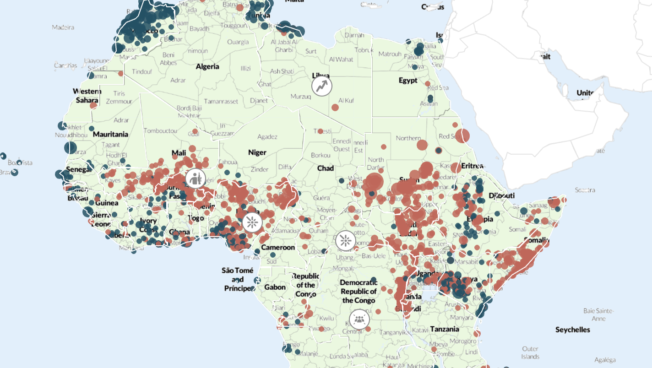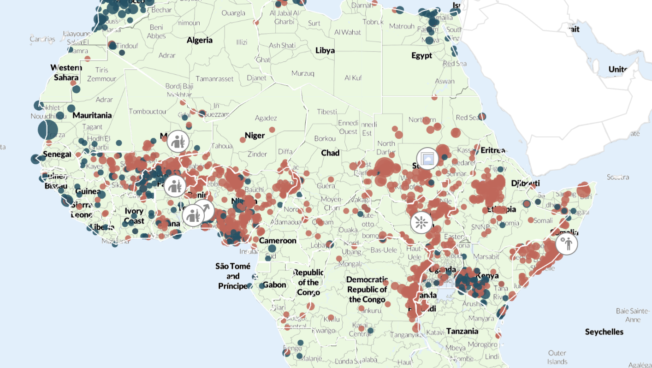Regional Overview
Africa
February 2025
Posted: 10 February 2025
In this Regional Overview covering January 2025
- Democratic Republic of the Congo: The M23 and RDF take over Goma city
- Nigeria: Deadly clashes in northern states lead to a spike in fatalities
- Sahel: JNIM sustains pressure on urban centers in Burkina Faso and Mali
- Somalia: Remote violence involving Islamic State Somalia Province surges
- South Sudan: Deadly unrest breaks out in response to civilian targeting in Sudan
- Uganda: Political violence involving pastoralists rises
Democratic Republic of Congo: The M23 and RDF take over Goma city
In January, the March 23 Movement (M23) and Rwanda Defence Force (RDF) took control of Goma, the capital city of North Kivu province. The capture of the city follows a breakdown of peace agreements between the Congolese and Rwandan governments and the RDF’s renewed involvement in the conflict against the Congolese military in December. The intense fighting over Goma and related M23 offensives into North and South Kivu drove an increase in violence involving the M23. ACLED records more events in January 2025 involving the M23 than any other month since the rebel group resumed its offensive in 2021. The violence involving the M23 in January 2025 alone reached levels comparable to nearly a quarter of political violence involving the rebel group for all of 2024. While 85% of the violence involving the M23 took the form of battles fought against Congolese military forces and allied armed groups, civilians were also increasingly targeted last month. Violence against civilians increased particularly as a result of numerous artillery strikes by the M23 and RDF into civilian-populated areas.
The takeover of Goma and surrounding areas in January has further permitted the M23 to embed itself in the local political administration of the province and generate lucrative tax revenues. Further, the control of the border town creates a security buffer zone for Rwanda by pushing insecurity further from the border and reorients the flow of goods and minerals in the region toward Rwanda.1Koen Vlassenroot and Judith Verweijen, ‘Congo crisis extends beyond “conflict minerals,’’’ Egmont, 31 January 2025 Numerous economic activities have already restarted in Goma as the M23 and RDF look to show their capacity to govern and administer the city.2Al Jazeera, ‘Tense calm, fears for the future in DRC’s Goma a week after M23 takeover,’ 3 February 2025
In addition to overtaking Goma, the M23 mounted a southward offensive into South Kivu province, reaching areas north of Kalehe by 29 January — over halfway to the South Kivu provincial capital of Bukavu from Sake town. The rapid pace of the southward offensive sparked concerns over the limited resistance faced by the M23 in the region and showed broader M23 interest beyond Goma. ACLED data show that the M23 and RDF were able to rapidly advance into South Kivu in part because the joint force had already engaged in widespread clashes and taken control of areas from Congolese forces around Minova town, situated in the northern part of South Kivu province, earlier in January. Despite the initial southward surge, Congolese forces and allies regrouped north of Bukavu, where clashes were ongoing in early February.
Nigeria: Deadly clashes in northern states lead to a spike in fatalities
In January, the Nigerian military and other auxiliary forces engaged in armed clashes with bandits and Islamist insurgents in northern Nigeria. The military mobilized several local self-defense militias and Civilian Joint Task Force (CJTF) in Borno, Katsina, and Zamfara states. The operations come in response to the Chadian military pushing insurgents across the border in late 2024, along with increasing concerns about insurgent connections in the northwestern states. Clashes were most numerous in Zamfara state, where Operation Fansan Yamma targeted several leaders of armed bandit groups. The fighting resulted in the reported killing of Zamfara bandit leaders, including Na’ballo and Aminu Kanawa.3Hadiza Musa, ‘Zamfara: Notorious bandit leader Na’ballo killed in clash,’ Daily Post, 21 January 2025; Mevlut Ozkan, ‘Army kills top terrorist, 31 others in violence-ravaged northwest Nigeria,’ Anadolu Ajansi, 23 January 2025 Military forces also conducted operations in Katsina state to curb Katsina-based bandits that had imposed levies on numerous communities in neighboring Zamfara state.4Njadvara Musa and Danjuma Michael, ‘80 bandits killed in Katsina as hoodlums levy Zamfara communities,’ The Guardian Nigeria, 7 January 2025 The ability of bandit groups to loot and carry out violence in other states underlines the interconnectedness of conflict in the northwest of Nigeria.
Although clashes were less numerous than in Zamfara state, Borno state was also the site of heavy fighting that resulted in over 200 reported fatalities. Nigerian security forces and CJTF, under Operation Hadin Kai, fought against Islamic State West Africa Province (ISWAP) and Boko Haram (JAS). The clashes focus on areas of Borno state with JAS strongholds and camps, commonly called the Timbuktu Triangle, which stretches across the local government areas of Damboa, Jere, Kaga, and Konduga.5Solomon Odeniyi, ‘22 soldiers, 70 terrorists killed in Borno military operation,’ Punch Nigeria, 27 January 2025 Insurgents responded by deploying advanced technological capacity, including surveillance drones, before launching ground offensives. ACLED records at least three instances when JAS or ISWAP used drones for attacks and surveillance since December 2024. The use of drones marks the first such events by Islamist insurgents in the Lake Chad region and may show a shift in operational capacity.
Sahel: JNIM sustains pressure on urban centers in Burkina Faso and Mali
After several months of public threats by the al-Qaeda-affiliated Jama’at Nusrat al-Islam wal-Muslimin (JNIM) of a plan to attack major cities in Burkina Faso and Mali, JNIM carried out around a dozen attacks in administrative capitals in the two countries in January. JNIM carried out armed attacks and detonated explosive devices in the administrative capitals of Burkina Faso’s Sahel, Centre-North, Centre-East, and Est regions. Several of these towns, including Djibo, Sebba, Kelbo, and Pama, have been under embargoes and blockades by JNIM for years. The attacks in Sebba and Pama were particularly deadly, resulting in nearly 80 reported fatalities and material destruction. In Mali, JNIM carried out two attacks on military positions in the administrative capitals of Nioro du Sahel and Diangassagou in the Kayes and Bandiagara regions. These events highlight a broader regional trend, where jihadist insurgents — once primarily confined to rural areas — are increasingly extending their reach into capital cities. The rapid pace of Sahelian urbanization, combined with militants strategically targeting major cities to maximize disruption, presents a significant security challenge for regimes across the region.
Somalia: Remote violence involving Islamic State Somalia Province surges
In late December, Puntland state security forces began operations against bases, training facilities, and camps associated with the Islamic State Somalia Province (IS Somalia) in the Buuraha Cali Miskat mountain range and nearby areas of Puntland’s Bari region.6Mohamed Olad Hassan, ‘Over 20 killed in clash between security forces, Islamic State fighters in Somalia,’ Voice of America, 21 January 2025; ADF, ‘Somalia Faces Critical Threat as Islamic State Group Expands in Puntland,’ 18 June 2024 In response, IS Somalia conducted a wave of explosive attacks in Bari in January. Unlike on other occasions, when IS Somalia resorted to IEDs and crude bombs, IS Somalia started to use drones to target the Puntland security forces. In two separate attacks on 20 and 23 January, IS Somalia targeted the Puntland Maritime Police Force and Puntland Dervish Force at a base in Buuraha Cali Miskat, reportedly killing two soldiers and injuring others. Officials in the region claim that IS Somalia launched similar drone attacks earlier in the month that were intercepted by security forces.7Somali Guardian, ‘At least one soldier killed in ISIS drone attack in northeastern Somalia’s Puntland state,’ 23 January 2025 Collectively, the drone strikes and at least seven other IEDs detonated by IS Somalia resulted in the highest levels of monthly remote violence since 2017. Shortly after the drone strikes, US President Donald Trump issued an executive military order to carry out airstrikes against IS Somalia positions in the Golis Mountains of Puntland.8Al Jazeera, ‘US strikes in Somalia killed “key” ISIL figures, says regional government,’ 2 February 2025
South Sudan: Deadly unrest breaks out in response to civilian targeting in Sudan
In January, demonstrations in South Sudan surged in response to ethnically targeted attacks by the Sudanese Armed Forces (SAF) on South Sudanese civilians in Sudan’s al-Jazirah state during the overtake of Wad Madani and surrounding areas.9Alrakoba, ‘Juba summons Sudanese ambassador to provide explanation on Sudanese army violations against South Sudanese citizens in Al-Jazeera State,’ 15 January 2025; Denis Elamu, Elias Biryabarema, and Alexander Winning, ‘South Sudan imposes curfew after Sudan killings trigger riots,’ Reuters, 17 January 2025 ACLED records 16 demonstrations in January. More than 60% of these demonstrations involved violence. Rioters looted and vandalized Sudanese-owned businesses, while at least 18 Sudanese and South Sudanese nationals were reportedly killed in the unrest.10Radio Tamazuj, ‘Death toll in South Sudan protests rises to 16,’ 20 January 2025 In Aweil, near the Sudanese border, rioters set fire to three homes belonging to Sudanese nationals, and at least nine people were killed.11Radio Tamazuj, ‘Violent protests in Aweil over killing of South Sudanese in Sudan,’ 17 January 2025 Security forces frequently fought with rioters, using force to disperse crowds, injuring several, and arresting anti-Sudan demonstrators across the country. On 18 January, the South Sudanese government imposed a nationwide curfew and restricted access to Facebook and TikTok, and a few days later, the National Communication Authority issued a three-month ban on these platforms.12Radio Tamazuj, ‘South Sudan government shuts down social media,’ 22 January 2025 Authorities lifted the curfew and social media ban 10 days later.13Hereward Holland, ‘South Sudan lifts suspension of Facebook and TikTok,’ 28 January 2025 Beginning on 11 January 2025 and continuing for several days, the SAF and allied militias reportedly killed over 120 civilians across al-Jazirah state, including South Sudanese nationals. Many South Sudanese nationals came to al-Jazirah as refugees, but the SAF often suspects them of collaborating with militia groups or supporting the Rapid Support Forces.14Sudans Post, ‘27 South Sudanese nationals killed by SAF-allied militias in Sudan’s Al Jazirah State,’ 16 January 2025
Uganda: Political violence involving pastoralists rises
Violence involving pastoralists in Uganda rose last month, prompted by a large-scale attack by a suspected armed Karamojong militia in Pian Upe Game Reserve in Nakapiripirit district. The raiders stole over 500 heads of cattle from ethnic Pokot pastoralists before security forces intervened to retrieve some of the stolen livestock. Armed clashes broke out between pastoralists and security forces and were followed by pastoralist militia attacks on civilians during cattle raids. The violence, which involved ethnic Karamojong along with Jie and Pokot pastoralists, was highest in Agago district and reached levels not seen in Uganda since April 2023, when the Ugandan military carried out operations against cattle raiders.
Security forces have spearheaded disarmament campaigns since July 2021 in the northeast of the country, where small arms have proliferated amongst the population. Police claim to have collected 1,275 small arms since the campaign began. Prior to the latest outbreak of violence, these efforts appeared to be showing signs of success as ACLED data shows a decline in violence involving pastoralists in 2024 compared to the previous year.
See More
See the Codebook and the User Guide for an overview of ACLED’s core methodology. For additional documentation, check the Knowledge Base. Region-specific methodology briefs can be accessed below.
Links:
For additional resources and in-depth updates on the latest political violence and protest trends, check our local observatories for Mozambique and Ethiopia, as well as our special Nigeria Election Violence Tracker project.







